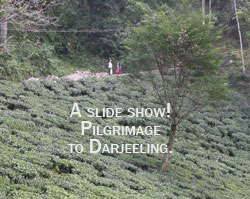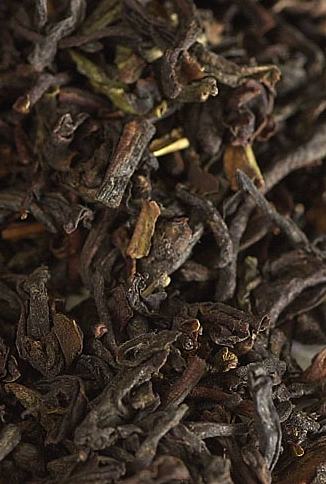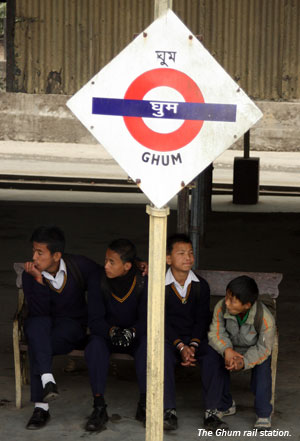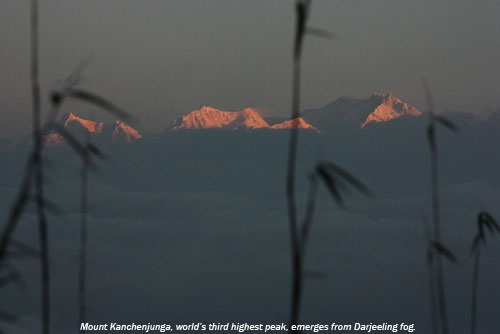 Everyone knows tea originally came from China. And that was literally millennia ago--Chinese tea cultivation goes back thousands of years. Tea drinking later reached Japan, and in the West from the 1600s on.
Everyone knows tea originally came from China. And that was literally millennia ago--Chinese tea cultivation goes back thousands of years. Tea drinking later reached Japan, and in the West from the 1600s on.Go back to Ross Collins travel.
A Tea Pilgrimage to Darjeeling
 Everyone knows tea originally came from China. And that was literally millennia ago--Chinese tea cultivation goes back thousands of years. Tea drinking later reached Japan, and in the West from the 1600s on.
Everyone knows tea originally came from China. And that was literally millennia ago--Chinese tea cultivation goes back thousands of years. Tea drinking later reached Japan, and in the West from the 1600s on.
People in England particularly liked tea. So much that by the early 1800s it was the principal export of the British East India Company. That company enjoyed a monopoly on tea importation to the West, based on a production monopoly, that of China.
All tea at that time came from China. Its production was quite a bit more than its consumption. It had used tea as currency for some time. Tea was used in trade for war horses from Tibet as early as the 1100s.
China's currency of tea was part of its state security, things considered central to the power of the Chinese government. This meant tea cultivation was a closely held secret. It was forbidden to take seed or slips from a tea plant, or for a tea worker to show anyone outside of the country how tea was made.
The problem of Britain was that while folks loved tea, the country really didn't have anything the Chinese wanted to trade for it. Apparently British war horses didn't measure up. Silver was good, but Britain was running short of silver to trade for tea.
 The British government did allow a growing opium market from India to replace silver as something the Chinese might like instead of silver, as trade for tea. But that led to more disagreements, and after the 1839 Opium War, the British realized they needed to find another source for tea.
The British government did allow a growing opium market from India to replace silver as something the Chinese might like instead of silver, as trade for tea. But that led to more disagreements, and after the 1839 Opium War, the British realized they needed to find another source for tea.
British-controlled India might be a good location to cultivate tea. But the British had no idea how to grow it. Some early plant breeders did notice an indigenous plant in the Assam region of East India called Camillia sinensis. Was it the same as Chinese tea? Many doubted it. In any case, who knew how to make tea from the plant?
The Dutch more than a century before had succeeded in smuggling tea plants from China to Java, as ornamentals. But nobody there knew how to make tea from the plants either.
In the 1830s, a Dutch trader named Jacobus Isidorus Longevijk Levien make six trips to China. He attempted to sneak away with both seeds and workmen for tea planting, despite his status as a wanted criminal in China.
Meanwhile, in Britain George James Gordon went to China on the same risky hunt. He did manage to bring back some seedlings. These were planted next to the indigenous plant in Assam--folks then didn't believe they were the same plant. Chinese laborers who managed to defect from China contributed the expertise to oversee the operation. So the first tea outside of China came to Britain from Assam.
Subsequent trips to China gave British workers more expertise to allow them to produce tea.
In 1841 a British civil servant, Dr. Arthur Campbell, decided to try some Camillia sinensis in the hills surrounding the mountain town of Darjeeling. West Bengal surrounds some of the world's highest mountains, and was British colonial territory. It attracted a summer crowd of vacationers. It also proved to be a good place to cultivate tea. In fact, tea from Darjeeling became so successful that it replaced China tea in world trade to become the world's highest quality black tea.
 Tea bushes require about three years before they are ready to pluck. They need to grow in Zone Eight, and like acid soil, with at least 50 inches of rainfall a year. Most high-quality teas are grown at an elevation of up to 5,000 feet. The tea of Darjeeling actually are not grown in that city, as at 6,710 feet, it's too high. Most of it is grown downhill from Darjeeling, closer to the city of Ghum (or Ghoom). So really we should call it Ghum tea!
Tea bushes require about three years before they are ready to pluck. They need to grow in Zone Eight, and like acid soil, with at least 50 inches of rainfall a year. Most high-quality teas are grown at an elevation of up to 5,000 feet. The tea of Darjeeling actually are not grown in that city, as at 6,710 feet, it's too high. Most of it is grown downhill from Darjeeling, closer to the city of Ghum (or Ghoom). So really we should call it Ghum tea!
Today the area around Ghum and Darjeeling is carpeted with tea bushes. Some of these are very old--the Happy Valley "tea garden", as the plantations are sometimes called, dates from the 1850s, and the bushes are between 80 and 120 years old. Happy Valley brags that they are suppliers of tea to Harrod's in London. When a friend and I visited Darjeeling, I had a chance to see three tea plantations: Happy Valley, Glenburn and Makaibari. The last one is most famous as having the world's most expensive tea, called silver tips. These are supposedly buds--immature leaves just opening--plucked under moonbeams, described as "ideally sipped at bed time to cull one to celestial slumber." That said, tea prices are not like wine; $20 buys 50 grams, enough to make quite a few cups.
A visit to Glenburn Estate.
Visiting Glenburn Estate was most difficult. It is down a steep single-laned trail studded with sharp boulders and ruts. Only a four-wheel drive or SUV could negotiate such a rough trail, and we bounced more than an hour before arriving (with only one flat tire). "I have never taken a tourist to this estate," said Dawi, the guide, "Most drivers wouldn't go down this path" I realized I'd be offering up a good tip for having requested Glenburn.
The staff at Glenburn seemed really puzzled at our visit. The guide said, in English, "He's a favorite buyer of Glenburn tea," although I told him earlier that while I'd heard of it, I wasn't actually certain I had ever bought that tea. In any case, playing along, I added, "Yes, I've come half way around the world to see this estate!"
The staff asked me to produce a business card, which I did, from North Dakota State University. (I was surprised how useful business cards were in India.) They disappeared, returned, invited me to the estate's house for--a cup of tea.
I sat with the innkeeper, a matronly lady of a certain age, and two British women who happened to be visiting there. One rented a guest room to work on her book. Another taught at a school nearby during her "gap year," a year British students take out of the country to see the world and volunteer at some underprivileged and exotic location. "This is Glenburn autumnal," said the manager, pouring the tea.
"I'll have a bit of milk in mine," said the British writer. The staff loitering around stiffened. "We don't serve milk," whispered the innkeeper. Darjeeling tea is not like your basic Lipton's, and needs no milk to mask the bitterness. Milk in tea is sacrilege in Darjeeling.
Presently an agile man of about 40 appeared, and staff became quiet. Clearly, this was the boss. "This is Sanjay Sharma, tea planter," said the innkeeper.
"Someone who plants tea?" I asked.
 "No. The tea planter is the manager of the estate." They had brought the boss to meet the tourist from half way around the world.
"No. The tea planter is the manager of the estate." They had brought the boss to meet the tourist from half way around the world.
Sharma was clearly in a hurry, but still gracious enough to answer a few of my questions--after I had passed his lie detector test. How, he asked, did I know about Glenburn tea?
"I order it from Upton Tea Company, in the United States," I responded.
He was familiar with that company. "Well, any fan of Glenburn is welcome here," he said.
Sharma explained the tea operation. Tea in Darjeeling is harvested four times a year: around March, around June, in late summer, and in the fall. Winter is dormant season in Darjeeling, and begins in November. Alas, I was there on Nov. 14, two weeks after the fall plucking season had ended.
The first harvest is called first flush. Second is called second flush. Third is during the rainy season, so called monsoon flush. Fourth is autumnal flush.
Harvest means that only the first two leaves and a bud are plucked--the word for picking the tea leaves. "We are a quality tea operation, so our pluckers must be careful to pick only those leaves, no other," said Sharma. "This means one plucker gets about 500 grams a day." That's a little over a pound.
"First flush" does not necessarily mean finest quality. It simply means a tea harvested in the spring. "It is a delicate tea color, but with a strong bite," said Sharma. "But many of our clients, particularly in Japan, prefer second flush. That's a darker, stronger tea." Also generally the most expensive.
In fact, it is also true in the United States that most quality Darjeeling sold is second flush. First flush is certainly easily available--but not locally. Catalog or online is the way to get quality single-estate Darjeeling. I do order from Upton Tea--so I wasn't lying to the Glenburn people!
The monsoon flush is darker and more earthy, and autumnal is darkest and most full bodied. They are stronger in flavor and so considered of lower quality, and less popular than first and second flush. Monsoon tea usually stays in India and is sold for the sweet spicy drink called masali chai. It's in the cup you usually get free for haggling at a carpet or jewelry dealer in Mumbai. "Chai" is just the word for "tea" in Hindi and many other languages.
Most Darjeeling tea is black tea. This means it's "fermented." Not exactly--more like it's oxidized. The tea leaves are first dried on long wire racks overnight, with blowers, cool in the daytime, warm at night. They are then scooped up and curled--usually by machine. This bruises the leaves. The curling machine in the Happy Valley plantation dated from the 1850s, from London. The fermentation is actually a second drying process. The curled leaf produces moisture that oxidizes. How long to ferment is dependent on the nose and judgment of the tea planter. Black tea is 90 percent oxidized, after which it is dried to stop the process and preserve the tea leaves from spoilage.
Green tea, on the other hand, is not oxidized at all. Oolong tea is oxidized a bit, about 10 percent. Sharma said most Darjeeling tea gardens produce black tea because it commands higher prices at auction.
After fermentation and drying, the now black tea is worked through a machine to grade. Tea is graded by size. Large leaf is generally higher quality. The dust, or fannings, are sold for teabags. As I was walking around in stocking feet--no one wears shows in the plants--the fannings collected in a five-foot high pile in the corner. No one had much respect for fannings.
Graded tea is poured into sacks, and shipped to the tea auction in Kolkata--Calcutta, south of Darjeeling. There the price is set, and it is shipped around the world.
No tea outside of this geographical area can sell as Darjeeling--just as no wine outside of Burgundy in France can sell as Burgundy. Of course, it's hard to police such a guarantee outside India, and tea sold as "Darjeeling" often isn't.
Grading of tea as indicated on a package seems complex, with a string of letters stamped on a tea chest.
Sometimes you'll see many letters applied to tea indicating quality, such as SFTGFOP--Super Fine Tippy Golden Flowery Orange Pekoe or FTGBOP--Fine Tippy Golden Broken Orange Pekoe. These generally don't really give you an idea of tea taste. Golden Flowery suggests more gold-colored young tips produced earlier in the growing season. These tea leaves have a variegated appearance. More Golden Tips suggest a higher quality tea, with "Tippy" being higher yet. But you can find excellent bargains in a Darjeeling lacking such arcane designations.
The process of harvesting by machine produces a broken CTC leaf, that is, "Crush-Tear-Curl." Machine harvest is rare in Darjeeling, Sharma said, but more common in Assam teas, in East India. The Assam harvester also will often pluck more than just two leaves and the bud. These processes produce more tea, but a stronger, more bitter product considered of lower quality. Assam teas are consequently cheaper than Darjeeling teas, and look like small pellets often used in teabags. The fannings and CTC tea certainly represent what most people expect when they think of "tea," and so it's not surprising in Britain that the usual method of preparation is to add milk to tame the strong bitter flavor. Good Darjeeling properly steeped is slightly astringent, but not bitter, and offers a slightly floral taste.
Most tea grown outside of Darjeeling is sold in the West as blends, and the cheaper Darjeeling also often is a blend. This doesn't necessarily mean low quality, although in my experience the Darjeeling blends I've tried just haven't measured up to the single-estate teas.
Teabag tea infuses fast--one minute may be too long. Whole leaf Darjeeling, on the other hand, usually needs about three to four minutes. Water just off the boil should cover about one rounded teaspoon of tea per cup. Just place the leaves in the teapot. Strain with a tea filter to drink. Black tea keeps a long time--two years is not unreasonable, except for first flush, which should be used more quickly.
Tea is supposedly healthy, based on its polyphenols in the tannins. But the research on health benefits of tea, green or black, is still inconclusive. Tea does contain more caffeine by weight than coffee, but because it's so light, you use less in a cup.
I asked the Glenburn tea garden staff about that--why not plant coffee? It's pretty much the same growing conditions, after all. "We do grow, in the south," the innkeeper answered. "Actually, we could grow coffee right here, instead of tea! But why have one harvest per year when you can have four?"
The manager returned to usher me to the waiting Tata 4X4. "Well, thanks for coming, he said. "We do have a web site. You can buy directly from us. Our prices are not set here. They are set by the tea auction in Calcutta. We have your card. We'll send you an email with the address."
The Glenburn visit took about two hours. I had the distinct impression Glenburn Tea Estate had never before seen a lone tourist intrepid enough to hire a vehicle, hire a guide, and find the operation on his own, and so did not know quite what to do with me. On the way back up the road, Dawi the guide mused, "I've never had a tourist so interested in tea." But he didn't realize that, for someone from Fargo, this really was a once-in-a-lifetime trip.